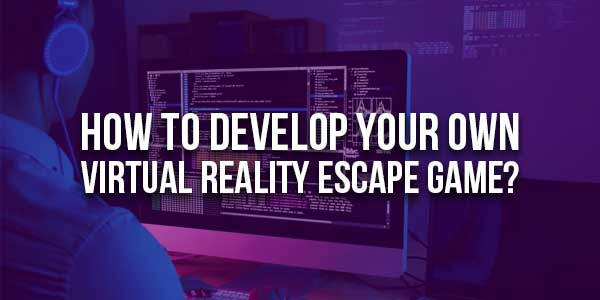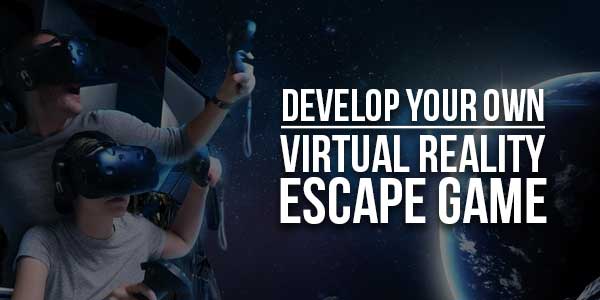
The opportunity to design immersive and difficult experiences for players to enjoy is provided by creating a Virtual Reality (VR) Escape Game. The ability to create your own VR escape game has never been greater thanks to developments in VR technology and readily available development tools.
So let’s get started!
Table of Contents
Let’s Understand What Is A Virtual Reality Escape Game!
A virtual reality escape game is a type of interactive entertainment that blends the idea of an escape room with aspects of virtual reality technology. In a conventional escape room, participants are imprisoned in a theme-based room and have a predetermined amount of time to solve a series of puzzles and tasks in order to escape. Participants in a virtual reality escape game don a headgear that immerses them in a computer-generated world, thus substituting the actual room with a virtual one.
The goal of a virtual reality escape game is the same as it is in a traditional escape room: to progress and eventually escape by solving puzzles, uncovering clues, and completing tasks. Participants can explore fanciful and immersive environments in a virtual reality environment, which may not be achievable in a physical area.
Market Stats:
According to Allied Business Research, the escape room business has grown significantly in recent years, with a projected $7.9 billion global market in 2022.
The small theme room segment, intended for 2 to 4 individuals, topped the market in 2022 among the many escape room subtypes. Throughout the period of forecasting for the escape room market, it is projected that this market segment will hold onto its market share. Recently, small-scale theme escape rooms have become more well-liked as a kind of entertainment and social activity.
The Virtual Reality Environment Setup:
Participants use a VR headset, such as an Oculus Rift or HTC Vive, which creates a totally immersive experience by obstructing the real environment and replacing it with a virtual one, to start a Virtual Reality Escape Game.
Engaging In The Virtual World:
After entering the virtual world, participants can use mobile devices or specialized controllers to interact with things and their surroundings. Players can reach out, pick up objects, manipulate them, and solve puzzles within the virtual world thanks to these controllers that are tracked in real-time.
Identifying And Resolving Puzzles:
Players in virtual reality escape games must solve a number of puzzles, chores, and challenges in order to advance and ultimately escape. Both critical thinking and observational skills must be used by the players. Even physical coordination is required occasionally to get past obstacles and solve the game’s puzzles.
Collaboration And Multiplayer Gaming:
Virtual reality escape games frequently give players the opportunity to play in multiplayer mode, enabling them to cooperate and solve puzzles with friends, family, or even complete strangers.
Potential Features Of Virtual Reality Escape Room:
We will examine the essential components that define a really interesting and memorable virtual reality escape room in this blog part.
Responsive And Intuitive Controls:
Virtual reality escape rooms need to have responsive and intuitive controls so that users can fully immerse themselves in the virtual world. The controls should feel natural and enable users to engage with items and change their surroundings without effort, whether they be gesture recognition, portable motion controllers, or other input devices. Players can concentrate on resolving puzzles and advancing through the game with this degree of control, which guarantees a flawless and immersive experience.
Difficult Puzzles:
The riddles and challenges that make up an Escape Room experience are at its core, and Virtual Reality Escape Rooms should include a wide range of interesting and thought-provoking tasks. A variety of tasks keep players interested and motivated, from logic problems and pattern identification to hidden item hunts and physical encounters. The puzzles should strike a balance between being difficult enough to foster critical thinking and problem-solving abilities while remaining manageably annoying so that players are motivated to advance.
Storyline And Theme:
A Virtual Reality Escape Room’s depth and immersion are increased by a compelling plot and well-designed theme. An engaging story can motivate the player to flee and give them a feeling of direction throughout the game. An engaging tale coupled with an immersive theme transports players into a new universe and improves their whole experience, whether it’s a thrilling adventure, a mystery to solve, or a sci-fi quest.
Multiple-Players:
Multiple players can cooperate to solve riddles and escape in virtual reality escape rooms, which makes it possible for friends, family, and even complete strangers to participate. By enabling multiplayer, the experience gains a social component that encourages interaction, collaboration, and shared success. The capacity to cooperate and plan with others increases enthusiasm and motivates players to make use of one another’s talents to overcome obstacles.
Levels Of Increasing Difficulty:
Progressive difficulty levels should be included in virtual reality escape rooms to accommodate participants with varied ability levels. Players are kept interested and feel successful as they advance by starting with comparatively simpler obstacles and progressively increasing the difficulty. Both novice and seasoned players can enjoy the game at their own speed and feel challenged throughout thanks to the option to change the difficulty level.
Development Steps To Create A Virtual Reality Escape Game:
We have provided you with a road map for building your virtual escape room by outlining the critical development processes needed in making a VR escape game.
Planning And Preparation:
To create a virtual reality escape game, you must first design your game concept and create a clear plan for how it will be carried out. Think about the game’s theme, plot, puzzles, and general gaming mechanics. Set clear objectives for your game and identify your target demographic. Make a development plan as well, outlining the project’s budget, schedule, and resource requirements.
The Virtual Environment’s Design:
Making an immersive Virtual Reality Escape Game requires careful consideration of the virtual environment. Establish the visual aesthetic, make precise 3D models of the surroundings and objects, and develop the interactive features. Create a compelling and lifelike virtual world by paying close attention to lighting, textures, and atmosphere. If you want to improve immersion and give the player a sense of presence in the game, think about using spatial audio.
Designing Puzzles And Gameplay Mechanics:
Create a range of difficult and interesting riddles for players to solve in order to advance through the game. Think about interactive games that need players to engage with the virtual environment and manipulate items, such as logic puzzles, riddles, hidden object hunts, and more. Make sure the puzzles are simple to understand, have a good balance of difficulty, and get harder as the player levels up. Playtest the puzzles often to improve their design and make sure you have a fun time solving them.
Development And Programming:
The logic, interactions, and game mechanics are coded during the programming and development stage. This level entails designing player movements, object interactions, and puzzle mechanisms in addition to integrating virtual reality technologies. To make development easier, pick an appropriate game engine like Unity or Unreal Engine. Utilize the capabilities of VR controllers or other input devices to implement fluid and responsive controls. To eliminate any defects or problems that may develop, test frequently and iterate.
User Experience And User Interface:
Create a user interface (UI) that is simple to use so that players can easily access game features, navigate menus, and monitor their progress. Consider adding visual cues or suggestions to direct players as necessary. Make sure the UI components are understandable, pleasing to the eye, and clear. Pay close attention to the user experience (UX) to create an immersive gaming flow that minimizes any potential discomfort or confusion that may result from VR interactions.
Evaluation And Improvement:
To find and correct any flaws, malfunctions, or gameplay imbalances, extensive testing is necessary. To ensure compatibility and ideal performance, test the game on various VR platforms and equipment. Obtain playtesters’ feedback to gain an understanding of the game’s advantages and shortcomings. Update and improve the game frequently based on user feedback, making the required changes to improve the overall experience.
Release And Distribution:
It’s time to release and share your Virtual Reality Escape Game with the intended audience once it has been polished and improved. Think about making the game available on well-liked VR stores like the Oculus Store or SteamVR. To raise awareness and draw gamers, create promotional materials, trailers, and marketing efforts. Support your game after it has launched by offering updates, fixing bugs, and even adding new levels or content to keep people interested.
Factors Affecting The Cost Of Virtual Reality Escape Game:
Let’s look at the main elements that influence the cost of developing a virtual reality escape room game to gain insight into the cost aspects of such an immersive gaming experience.
Conceptual And Design Difficulty:
The cost of construction is strongly impacted by the VR escape game’s concept and design intricacy. The development costs rise as the virtual world becomes more complex and rich, incorporating 3D models, textures, lighting effects, and interactive components. The price is also influenced by the quantity and difficulty of puzzles and gaming elements.
Tools And Development Platform:
The price of developing a virtual reality escape room game might be impacted by the platform and tools that are used. The tremendous capabilities of well-known game engines like Unity or Unreal Engine come with possible license costs or revenue-sharing agreements. In comparison to the associated costs of the development tools you decide to use, weigh the unique features and compatibility requirements of your game.
VR Technology:
A large expense component for a virtual reality escape room game can be the hardware and VR equipment needed. This includes computer systems with enough computing power, motion controllers, sensors, and VR headsets. Additionally, the quality, brand, and features of VR equipment can have a significant impact on the pricing range and technical parameters. Compare the desired level of performance and immersion to the budget that is at your disposal.
Graphic Design:
The building cost of a VR escape game is influenced by the visual components, which include art assets, graphics, animations, and visual effects. Skilled artists and designers are needed to provide high-quality, realistic, and immersive images, which raises the cost of production. The cost is affected by the level of complexity, depth, and customization needed for the virtual environment and objects because these factors need more time and resources.
Designing Audio And Sound:
In order to create an immersive experience in a VR escape room game, audio and sound design are essential. Voiceovers, music, sound effects, and background noise all fall under this category. The cost of producing high-quality audio assets might increase if professional audio engineers and composers are hired. Additionally, employing spatial audio technology to improve the immersive experience could call for extra resources and know-how.
Tests And Quality Assurance:
For a Virtual Reality Escape Room Game to be polished and bug-free, thorough quality assurance and testing are essential. The cost of the building is affected by allocating enough time and resources for testing, bug-fixing, and optimization. The overall quality of the game improves with more thorough testing that includes both internal and external playtesting, but it also has an effect on the budget.
Updates And Post Launch:
Think about the price of offering updates and post-launch maintenance for your VR escape game. Bug fixes and the addition of fresh material are included in this. A positive player experience is ensured by continuing to support and improve the game after it has been released, although doing so needs ongoing resources and could result in extra costs.

Case Study: Virtual Reality Escape Room Game:
The top publisher and producer of video games, Ubisoft, has pioneered virtual reality (VR) gaming. Escape the Lost Pyramid, a VR escape room game that was based in the Assassin’s Creed Origins universe was released in 2017. Both critically and commercially, the game was successful. Additionally, it paved the path for additional VR escape room games.
Prince of Persia: The Dagger of Time and Beyond Medusa’s Gate are two further VR escape room games that Ubisoft has released since then. Fans have generally enjoyed these games. Ubisoft is now a top producer of VR escape room games as a result of these games.
Why Are Ubisoft’s Virtual Reality Escape Room Games So Popular?
The success of Ubisoft’s VR escape room games can be attributed to a few important elements. The first thing is that each game is based on a well-known Ubisoft title, such as Assassin’s Creed or Prince of Persia. A decent VR escape room game has to have a strong sense of familiarity and immersion, which is provided by this.
Second, each game has a solid concept and is difficult. The challenging puzzles require cooperation to complete.
Third, each game has outstanding visuals. The VR escape room games developed by Ubisoft continue their tradition of exquisite game design. Additionally, the environments are richly drawn and compelling, and the characters are realistic.
The Future Of VR Escape Room Games:
Although they are a relatively new genre, VR escape room games are becoming more and more well-liked. One of the top producers of VR escape room games is Ubisoft, and they will probably keep making new titles in the future.
VR escape room games will become even more immersive and intriguing as VR technology advances. As a result, it’s feasible that VR escape room games will eventually become widely popular forms of entertainment.
Top 5 VR Escape Room Games:
Immersive and exhilarating experiences are provided by virtual reality (VR) escape room games. Here are the top 5 games available right now:
The Room VR:
A Dark Matter is an enigmatic environment with gorgeous sights and challenging challenges.
I Expect You To Die:
A spy-themed game with deft puzzles and exciting settings
Virtual Virtual Reality:
A game that challenges the imagination with fantastical settings and challenging riddles.
Escape Room VR:
With realistic locations and captivating stories, it offers a variety of different escape room adventures.
Moss:
Incorporates aspects of an enthralling adventure and escape rooms, leading a brave mouse through challenges and traps.
The Key Technologies For Making A Virtual Reality Escape Room Game:
There are a few key technologies you should be aware of if you’re interested in creating a VR escape room game.
VR Headset:
A VR headset is the first and most necessary piece of technology you’ll require. There are several alternative VR headsets available, but the Oculus Rift, HTC Vive, and Valve Index are the most often used for game development.
AR/VR Engine:
A software platform called a VR engine enables the creation of VR experiences. Although there are other VR engines available, Unity and Unreal Engine are the most widely used for game development.
3D Modeling Applications:
To design the assets for your VR game, you’ll need 3D modeling software. There are many other 3D modeling software packages available, but Blender and Autodesk Maya are the most widely used for VR production.
Audio Programs:
High-quality audio is necessary for VR games to produce an immersive experience. To generate and combine the audio for your game, you’ll need audio editing software. Audacity and Adobe Audition are two of the most well-known audio creation tools for VR.
Scripting Language:
To manage the behavior of your VR game, you’ll need a scripting language. Python and C# are the most often used scripting languages for VR development.
Libraries Of VR Assets:
Numerous VR asset libraries provide both free and commercial assets. When building the assets for your game, these libraries can help you save a lot of time and work.
Tutorials For VR Development:
You may learn the fundamentals of VR development via a variety of online tutorials that are available. If you’re new to VR development, these tutorials can be a wonderful place to start.
Developer Forums For VR:
You may ask questions and find support from other VR developers on a number of development forums. As a result, you can discover a lot of information about your questions in these forums. Additionally, they are helpful for obtaining assistance for your VR development projects.
Conclusion:
For both producers and players, creating your own Virtual Reality (VR) Escape Game may be a fulfilling and engaging experience. You may develop a captivating VR escape room game by following the instructions and bringing your vision to reality.
FAQ’s:
What Are The Steps For Creating A Virtual Reality Escape Game?
Conceptualization and planning are the main elements in creating a virtual reality escape game. Additionally, it entails programming, development, designing the virtual world, and coming up with interesting puzzles. Thorough testing, improvement, launching, and distribution are other processes.
Is Programming Experience Necessary To Create A VR Escape Game?
Even though having prior programming expertise might be useful, considerable programming knowledge is not always required. Visual scripting tools can also be provided by using user-friendly game development platforms like Unity or Unreal Engine. Additionally, they offer resources that help folks without substantial coding skills more easily approach game production.
What Role Does Testing Play In The Development Process?
To provide a seamless and enjoyable gaming experience, testing is essential. Regular testing assists in finding and fixing errors, improving performance, and gathering suggestions for enhancements. It guarantees that the game is well-polished and lives up to players’ expectations.
How Much Does It Cost To Develop A VR Escape Game?
The price of creating a VR escape game might vary depending on a number of factors. These elements include the degree of the game’s design intricacy and the caliber of the graphics and soundtrack. Additionally, the development tools selected and the level of customization are important. It is advised to make a budget that takes hardware, software, and marketing costs into account.

 About the Author:
About the Author:
















Be the first to write a comment.